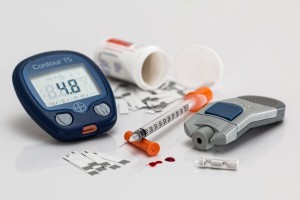
November marks American Diabetes Month, and is therefore an appropriate time to discuss Diabetes Mellitus (DM). DM was first described in 1500 BCE in an Egyptian manuscript as a disease associated with increased urination (polyuria), and in fact the very name “diabetes,” which means “to pass through” was first used by the Greek Appollonius of Memphis in 230 BCE due to this common symptom of the disease. The other two primary symptoms of DM are polydipsia (increased thirst) and polyphagia (increased hunger).
Normally, when a person eats carbohydrates, complex sugars are consumed, digested, and broken down into simple sugars (ex. glucose) which are sent to the bloodstream. Glucose is transported to the body cells where it is absorbed and metabolically broken down through cellular respiration in the cells’ mitochondria. This process produces ATP, or energy, and enables us to function and perform our activities of daily living. Insulin, which is produced in the pancreas, is vital to this process- it enables transport of glucose into the cell. However, with DM, a person experiences hyperglycemia, increased blood sugar levels due to interference of glucose transport into the cells.
There are generally two reasons for this abnormality: either the beta cells of the islets of Langerhans in the pancreas are not properly producing insulin (Type 1 or Insulin Dependent DM) OR the insulin is being produced, however the person has developed an insulin resistance (Type 2 or Non-Insulin Dependent DM), thus preventing glucose from entering the cells. In addition, a third type of diabetes known as gestational diabetes may develop in some pregnant women. It is associated with decreased insulin secretion, hence interrupted glucose transport. The prevalence of gestational diabetes is 2-5% of all pregnancies, and it usually resolves spontaneously after childbirth. There is a correlation between gestational diabetes and future development of Type 2 DM. In fact, approximately 20-50% of women who experienced gestational diabetes while pregnant eventually develop Type 2 DM.
When glucose can’t enter the cells, the blood-glucose level (BGL) can rise quite high. However, because of the lack of insulin to move the glucose from the blood into the cells, despite the bodies high overall BGL, the cells are forced to rely on metabolizing fatty acids for energy.
While safe in the short-term, when this source of energy is used for too long, ketones (a byproduct of fatty acid metabolism) build-up in the bloodstream leading to a dangerous condition called Diabetic Ketoacidosis (DKA). The symptoms of this condition include breath that smells like acetone, fast and heavy Kussmaul breathing pattern, vomiting, nausea, abdominal pain, and possibly even altered states of consciousness (ex. coma). Glucose accumulation in the eye lens can also create vision difficulty due to altered lens shape. Diabetic dermadromes are a specific type of rash that may develop with DM. Furthermore, some individuals with DM develop peripheral neuropathy, dysfunction of the nerves that send messages to the extremities (especially the lower extremities). This may result in decreased sensation to the feet and decreased strength in the leg muscles.
The predominant form is Type 2 DM, and it is associated with obesity. Insulin treatment became available in 1921, and this can help facilitate glucose absorption in Type 1 DM. However, pumping more insulin into an individual with Type 2 DM does not correct the issue, because their bodies no longer respond to insulin. Therefore, it is important for individuals with any type of DM, especially Type 2, to make lifestyle changes that will promote health and prevent further medical complications. For example, exercise has been shown to facilitate glucose transport into the cell (similar to insulin)! Appropriate management of the disease (which to date cannot be cured) includes maintaining healthy blood pressure, exercising regularly, maintaining a healthy body weight, terminating smoking, and regular foot inspection to assure skin integrity. Furthermore, as a general rule, individuals with DM should not cut their own toenails due decreased sensation which increases the risk of sustaining an accidental injury.
According to Dr. Griffin P. Rodgers, Director of NIDDK National Institute of Diabetes and Digestive and Kidney Diseases, a division of the National Institutes of Health (NIH), “For many millions of Americans, diabetes is a lifelong burden. But it does not have to be a lifelong barrier to better health…People are not powerless when it comes to management of diabetes. Research led by NIH has shown that working to control blood glucose, or blood sugar, can have a lifelong effect on health, dramatically lowering the risk of many complications of diabetes… Supporting a person with diabetes can start small. Ask your loved one to show you how he or she is managing the disease. What goals have been set? What gets in the way of reaching goals? How can you help? For people with diabetes, managing the disease is a balancing act, and your needs can change over time. Caring for your health is a matter of trying and learning what works best for you. Family, friends, health care professionals, and communities all belong on your team.”
Please refer to National Diabetes Education Program for additional information from the NIH.


